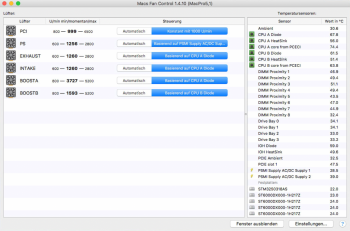@friolz: 5 minutes is pointless. You can do it for 1 second. The point is that the PC GPU starts in 3D acceleration mode when the computer powers on, and the Mac doesn't tell it to go into 2D mode. But starting and closing a 3D application makes the Mac tell the GPU to calm down and enter 2D mode, which makes the GPU go into power-saving mode which in turn generates less power draw on the PSU which in turn makes the Mac's miscalibrated fans run quieter.
There are two ways to fix the fan noise:
1. The way I proposed, which reconfigures the Mac fan speeds to be based on heat instead of how many watts they draw from the PSU.
2. The way you and many others proposed, which starts and closes a 3D application to get the GPU into low-power 2D mode which means less wattage which means slower Mac fan speeds. However, that method doesn't solve the noise you'll get if you play games or use any other 3D applications, since the power draw will then rise again and so will the Mac fan noise.
There is a third way, actually (which would benefit even people who use method 1):
3. nVidia could recode their Web Driver to put the GPU into 2D mode at startup, since macOS itself isn't smart enough to do it. This would save more electricity even for people who use method 1. And it would completely eliminate the need for method 2. Does someone want to take care of the task of contacting nVidia and trying to get them to do this?
I doubt if the problem is the GPU stay in 3D mode.
When the fan spin fast after boot, the power draw is actually low.
I personally use method 1. If your theory is right, the card will stay at 3D mode regardless I use a custom fan profile. So, it will draw more power and stay hot, and eventually spin up the fan. However, this is clearly not the case on my Mac. It looks more like a simple SMC bug that make the fan spin fast, and a little bit stress on the GPU can make the fan back to normal.
In fact, there is a 4th solution. Install the card at slot 2. If someone don't need all 4 slots, this is actually a simple solution.




